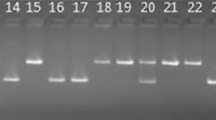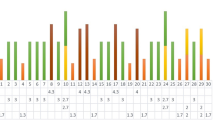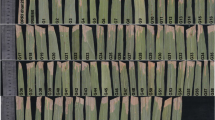Abstract
The main goal of this study is to gain insight into the relationship between the genetic profile of cultivated rice (Oryza spp.) accessions and their resistance to rice blast. Therefore, the genetic and phenotypic variability of a set of 350 cultivated rice accessions originating from Africa (Benin, Mali and Nigeria, Ivory Coast etc.) was examined. Seventy-seven fluorescent amplified fragment polymorphism (AFLP) markers were used to gain insight into the genetic variation and to classify the germplasm collection. In addition, the rice germplasm was assessed for its resistance to blast disease caused by Pyricularia oryzae in upland field conditions. Huge differences in responses of rice accessions to P. oryzae were observed, ranging from highly susceptible to highly resistant. Twelve percent of all accessions were highly resistant to P. oryzae. Based on their AFLP marker profile these highly resistant accessions could be separated from the other accessions. Stepwise regression revealed that the best prediction of the blast resistance level was achieved with a maximum number of 13 AFLP markers. Marker CTA22 was the most important for accurate prediction of blast resistance, this marker was present in all highly resistant accessions. It can be concluded that AFLP markers are a valuable tool to screen rice accessions for their susceptibility towards blast disease and that, based on a subset of markers, it is possible to predict the resistance to rice blast.



Similar content being viewed by others
References
Afouda L, Gnikpo S, Sere Y, Gumedzoe Y (2007) Prevalence des principales maladies sur des varietes de riz cultivees dans le departement de l’alibori au Nord-Benin. J de la Recherche Scientifique de l’Universite de Lome 9:1027–1988
Baboy L, Mateso R, Sabiti K (1995) Tests de résistance au champ vis-à-vis de la pyriculariose du riz au Zaire. Tropicultura 13:93–98
Ballini E, Morel JB, Droc G, Price A, Courtois B, Notteghem JL, Tharreau D (2008) A genome-wide meta-analysis of rice blast resistance genes and quantitative trait loci provides new insights into partial and complete resistance. Mol Plant Microbe Interact 21:859–868
Barry MB, Pham JL, Noyer JL, Billo C, Courtois B, Ahmadi N (2007) Genetic diversity of the two cultivated rice species (O. sativa & O. glaberrima) in Maritime Guinea. Evidences for inter-specific recombination. Euphytica 154:127–137
Botstein D, White RL, Skolnick M, Davis RW (1980) Construction of a genetic linkage map in man using restriction fragment length polymorphisms. Am J Hum Genet 32:314–331
Couch BC, Kohn LM (2002) A multilocus gene genealogy concordant with host preference indicates segregation of a new species, Magnaporthe oryzae, from M. grisea. Mycologia 94:683–693
Dai Y, Jia Y, Correll J, Wang X, Wang Y (2010) Diversification and evolution of the avirulence gene AVR-Pita1 in field isolates of Magnaporthe oryzae. Fung Genet Biol 47:973–980
Dramé KN, Sanchez I, Gregorio G, Ndjiondjop MN (2011) Suitability of a selected set of simple sequence repeats (SSR) markers for multiplexing and rapid molecular characterization of African rice (Oryza glaberrima Steud.). Afr J Biotechnol 10:6675–6685
Futakuchi K, Sié M (2009) Better exploitation of African rice (Oryza glaberrima Steud.) in varietal development for resource-poor farmers in West and Central Africa. Agric J 4:96–102
Hittalmani S, Parco A, Mew TV, Zeigler RS, Huang N (2000) Fine mapping and DNA marker-assisted pyramiding of the three major genes for blast resistance in rice. Theor Appl Genet 100:1121–1128
IRRI (International Rice Research Institute) (2013) Standard evaluation system for rice, 5th edn. International Rice Research Institute, Manila
Jia Y, Bryan GT, Farrall L, Valent B (2003) Natural variation at the Pi-ta rice blast resistance locus. Phytopathology 93:1452–1459
Jones MP, Dingkuhn M, Aluko GK, Semon M (1997) Interspecific Orza sativa × O.glaberrima Steud. Progenies in upland rice improvement. Euphytica 92:237–246
Jusu MS (1999) Management of genetic variability in rice (Oryza sativa L. and O. glaberrima Steud.) by breeders and farmers in Sierra Leone. PhD-thesis Wageningen University, The Netherlands
Li ZM, Zheng XM, Ge S (2011) Genetic diversity and domestication history of African rice (Oryza glaberrima) as inferred from multiple gene sequences. Theor Appl Genet 123:21–31
Linares OF (2002) African rice (Oryza glaberrima): history and future potential. Proc Natl Acad Sci USA 99:16360–16365
Mackill DJ, Bonman JM (1992) Inheritance of blast resistance in near-isogenic lines of rice. Phytopathology 82:746–749
Ming H, Fang-min X, Li-yun C, Xiang-qian Z, Jojee L, Madonna D (2010) Comparative analysis of genetic diversity and structure in rice using ILP and SSR markers. Rice Sci 17:257–268
National Research Council (1996) Lost crops of Africa. Volume 1: grains. National Academy Press, Washington, p 380
Ndjiondjop M-N, Semagn K, Gouda AC, Kpeki SB, Dro Tia D, Sow M, Goungoulou A, Sie M, Perrier X, Ghesquiere A, Warburton ML (2017) Genetic variation and population structure of Oryza glaberrima and development of a mini-core collection using DArTseq. Front Plant Sci 8:1748. https://doi.org/10.3389/fpls.2017.01748
Nuijten E, van Treuren R, Struik PC, Mokuwa A, Okry F, Teeken B, Richards P (2009) Evidence for the emergence of new rice types of interspecific hybrid origin in West African farmers’ fields. PLoS ONE 4(10):e7335. https://doi.org/10.1371/journal.pone.0007335
Odjo T, Ahohuendo BC, Onasanya A, Akator K, Séré Y (2011) Analysis of Magnaporthe oryzae population structure in Benin. Afr J Agric Res 6:6183–6188
Pham JL (1992) Evaluation des ressources génétiques des riz cultivés en Afrique par hybridation intra et interspécifique. Thèse Docteur et sciences, Université de Paris XI ORSAY (France), p 236
R Core Team (2017) R: a language and environment for statistical computing. R Foundation for Statistical Computing, Vienna. https://www.R-project.org/
RoyChowdhury M, Jia Y, Cartwright RD (2012) Structure, function and coevolution of rice blast resistance genes. Acta Agric Sin 38:381–393
Saghai-Maroof MA, Soliman KM, Jorgensen RA, Allard RW (1984) Ribosomal DNA spacer-length polymorphisms in barley: mendelian inheritance, chromosomal location, and population dynamics. Proc Natl Acad Sci 81(24):8014–8018
Salem KFM, Sallam A (2016) Analysis of population structure and genetic diversity of Egyptian and exotic rice (Oryza sativa L.) genotypes. C R Biol 339:1–9
Sano Y (1989) The direction of pollen flow between two co-occurring rice species, Oryza sativa and O. glaberrima. Heredity 63:353–357
Second G (1982) Origin of the genic diversity of cultivated rice (Oryza spp.): study of the polymorphism scored at 40 isozyme loci. Jpn J Genet 57:25–57
Semon M, Nielsen R, Jones MP, McChouch SR (2005) The population structure of African cultivated rice O. glaberrima (Steud.): evidence for elevated levels of linkage disequilibrium caused by admixture with O. sativa and ecological adaptation. Genetics 169:1639–1647
Séré Y, Fargette D, Abo ME, Wydra K, Bimerew M, Onasanya A, Akator SK (2013) Managing the major diseases of rice in Africa. In: Wopereis MCS, Johnson DE, Ahmadi N, Tollens E, Jalloh A (eds) Realizing Africa’s rice promise. CABI (H ISBN 9781845938123), pp 2013–228
Sharma T, Rai A, Gupta S, Vijayan J, Devanna B, Ray S (2012) Rice blast management through host-plant resistance: retrospect and prospects. Agric Res 1:37–52
Sié M, Ogunbayo SA, Dakouo D, Sanou I, Dembélé Y, N’dri B, Dramé KN, Sanni KA, Toulou B, Glele RK (2010) Evaluation of intra and interspecific rice varieties adapted to valley bottom conditions in Burkina Faso. Afr J Plant Sci 4:308–318
Thakur S, Singh PK, Das A, Rathour R, Variar M, Prashanthi SK, Singh AK, Singh UD, Chand D, Singh NK, Sharma TR (2015) Extensive sequence variation in rice blast resistance gene Pi54 makes it broad spectrum in nature. Front Plant Sci 6:345. https://doi.org/10.3389/fpls.2015.00345
Thiémélé D, Boisnard A, Ndjiondjop M, Chéron S, Séré Y, Aké S, Ghesquière A, Albar L (2010) Identification of a second major resistance gene to Rice yellow mottle virus, RYMV2, in the African cultivated rice species, O. glaberrima. Theor Appl Genet 121:169–179
Vasudevan K, Vera Cruz CM, Gruissem W, Bhullar NK (2014) Large scale germplasm screening for identification of novel rice blast resistance sources. Plant Sci 5:1–9. https://doi.org/10.3389/fpls.2014.00505
Vieira MLC, Santini L, Diniz AL, Munhoz CF (2016) Microsatellite markers: what they mean and why they are so useful. Genet Mol Biol 39:312–328
Vodouhe SR, Ojegui M, Amadji F (1981) Impact of blast on rice cultivation in People’s Republic of Benin. In: Proceedings of the symposium on rice resistance to blast, Montpellier, France, 18–21 March. Service de Pathologie Végétale, Montpellier, France, pp 27–33
Vos P, Hogers R, Bleeker M, van de Lee T, Hornes M, Frijters A, Pot J, Peleman J, Kuiper M, Zabeau M (1995) AFLP: a new technique for DNA fingerprinting. Nucl Acids Res 23:4407–4414
Wambugu PW, Furtado A, Waters DL, Nyamongo DO, Henry R (2013) Conservation and utilization of African Oryza genetic resources. Rice 6:29
Wang JC, Wen JW, Liu WP, Yan SR, Wang JQ, Ren JP (2010) Interaction studies between rice and Pyricularia grisea in Jilin Province, P. R. China. In: Jia, Y (ed) Proceedings of the 5th international rice blast conference, USA. USDA-DBNRRC, p 90
Wang JC, Jia Y, Wen JW, Liu WP, Liu XM, Li L, Jiang ZY, Zhang JH, Guo XL, Ren JP (2013) Identification of rice blast resistance genes using international monogenic differentials. Crop Prot 45:109–116
Wang M, Yu Y, Haberer G, Marri PR, Fan C, Goicoechea JL, Zuccolo A, Song X, Kudrna D, Ammiraju JS, Cossu RM (2014) The genome sequence of African rice (Oryza glaberrima) and evidence for independent domestication. Nat Genet 46:982–988
WARDA (1999) Program report 1996–1997. West Africa Rice Development Association, Bouaké, Côte d’Ivoire
Wisser RJ, Sun Q, Hulbert SH, Kresovich S, Nelson RJ (2005) Identification and characterization of regions of the rice genome associated with broad-spectrum, quantitative disease resistance. Genetics 169:2277–2293
Zeigler RS, Tohme J, Nelson R, Levy M, Correa Victoria FJ (1994) Lineage exclusion: a proposal for linking blast population analysis to resistance breeding. In: Zeigler RS, Leong SA, Teng PS (eds) Rice blast disease. CAB International, Wallingford, pp 267–292
Acknowledgements
Funding of this Research work by the Monsanto’s Beachell-Borlaug International Scholars Program (MBBIS) and the Flemish Fund for Scientific Research (BOF) with support of AfricaRice. Special thanks to the AfricaRice genebank for providing seed and the related information.
Authors contribution
OINY carried out the field works, the genotyping, data analysis and drafted the manuscript. KA participated in project design, genotyping, data analysis and revised the manuscript. SL participated in statistical analysis of data and revised the manuscript. DS, AD, WV, PVD, and GH participated in project design, data analysis and revised the manuscript.
Author information
Authors and Affiliations
Corresponding author
Ethics declarations
Conflict of interest
The authors declare that they have no conflict of interest.
Electronic supplementary material
Below is the link to the electronic supplementary material.
Rights and permissions
About this article
Cite this article
Yelome, O.I., Audenaert, K., Landschoot, S. et al. Exploring genetic diversity and disease response of cultivated rice accessions (Oryza spp.) against Pyricularia oryzae under rainfed upland conditions in Benin. Genet Resour Crop Evol 65, 1615–1624 (2018). https://doi.org/10.1007/s10722-018-0638-1
Received:
Accepted:
Published:
Issue Date:
DOI: https://doi.org/10.1007/s10722-018-0638-1




